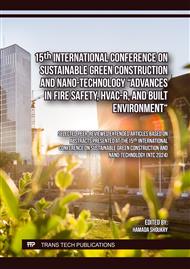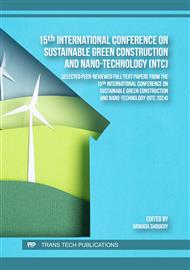[1]
Plastics Europe. Available online: http://www.plasticseurope.org
Google Scholar
[2]
Junod, T.L. Gaseous Emissions and Toxic Hazards Associated with Plastics in Fire Situations— A Literature Review; NASA-TN-D-8338; NASA: Washington, DC, USA, 1976.
Google Scholar
[3]
Y.W. Choi, D.J. Moon, Y.J. Kim, M. Lachemi, Characteristics of mortar and concrete containing fine aggregate manufactured from recycled waste polyethylene terephthalate bottles, Constr. Build. Mater. 23 (8) (2009) 2829–2835, https://doi.org/10.1016/j.conbuildmat. 2009.02.036.
DOI: 10.1016/j.conbuildmat.2009.02.036
Google Scholar
[4]
S. Safinia, A. Alkalbani, Use of recycled plastic water bottles in concrete blocks, Procedia Eng. 164 (June) (2016) 214–221.
DOI: 10.1016/j.proeng.2016.11.612
Google Scholar
[5]
A.K. Jassim, Recycling of polyethylene waste to Produce plastic cement,Procedia Manuf. 8 (October 2016) (2017) 635–642. doi:10.1016/j.promfg.2017.02.081.
DOI: 10.1016/j.promfg.2017.02.081
Google Scholar
[6]
R. Siddique, J. Khatib, I. Kaur, Use of recycled plastic in concrete: a review,Waste Manage. 28 (10) (2008) 1835–1852.
DOI: 10.1016/j.wasman.2007.09.011
Google Scholar
[7]
N. Saikia, J. De Brito, Use of plastic waste as aggregate in cement mortar and concrete preparation: a eview, Constr. Build. Mater. 34 (2012) 385– 401.
DOI: 10.1016/j.conbuildmat.2012.02.066
Google Scholar
[8]
L. Gu, T. Ozbakkaloglu, Use of recycled plastics in concrete: a critical review,Waste Manage. 51 (2016) 19–42.
DOI: 10.1016/j.wasman.2016.03.005
Google Scholar
[9]
R. Sharma, P.P. Bansal, Use of different forms of waste plastic in concrete – areview, J. Clean. Prod. 112 (2016) 473–482.
DOI: 10.1016/j.jclepro.2015.08.042
Google Scholar
[10]
P.K. Mehta, High-performance, high-volume fly ash concrete for sustainabledevelopment, in: Proceedings of the International Workshop on Sustainable Development and Concrete Technology, Iowa State University, Ames, IA, USA,2004.
Google Scholar
[11]
T. Hemalatha, A. Ramaswamy, A review on fly ash characteristics – towards promoting high volume utilization in developing sustainable concrete, J. Clea.Prod. 147 (2017) 546–559.
DOI: 10.1016/j.jclepro.2017.01.114
Google Scholar
[12]
C. Gunasekara, S. Setunge, D.W. Law, N. Willis, T. Burt, Engineering properties of polystyrene aggregate concrete, J. Mater. Civil Eng. 30 (11) (2018) 1–11, https://doi.org/10.1061/(ASCE)MT. 1943- 5533.0002501.
DOI: 10.1061/(asce)mt.1943-5533.0002501
Google Scholar
[13]
L. Yang, H. Yan, J.C. Lam, Thermal comfort and building energy consumption implications - a review, Appl. Energy 115 (15-Feb-2014) 164–173. Elsevier Ltd.
DOI: 10.1016/j.apenergy.2013.10.062
Google Scholar
[14]
D. Ürge-Vorsatz, L.F. Cabeza, S. Serrano, C. Barreneche, K. Petrichenko, Heating and cooling energy trends and drivers in buildings, Renew. Sustain. Energy Rev. 41 (01- Jan-2015) 85–98. Elsevier Ltd.
DOI: 10.1016/j.rser.2014.08.039
Google Scholar
[15]
D. Urge-Vorsatz, K. Petrichenko, M. Staniec, J. Eom, Energy use in buildings in a long-term perspective, Current Opinion in Environmental Sustainability 5 (2) (01- Jun- 2013) 141–151. Elsevier.
DOI: 10.1016/j.cosust.2013.05.004
Google Scholar
[16]
Soussi, Yamna, et al. "An embedded concept for sustainable building." Materials Today: Proceedings 72 (2023): 3556-3563.
DOI: 10.1016/j.matpr.2022.08.307
Google Scholar
[17]
Housing and Building National Research Center [HBRC], Green Pyramid System for Evaluating Building Sustainability, issued by Ministerial Resolution No. 294 – 2017.
Google Scholar
[18]
ASTM C-518 "Standard Test Method for Steady-State Thermal Transmission Properties by Means of the Heat Flow Meter Apparatus.
DOI: 10.1520/c0518
Google Scholar
[19]
European Committee for Standardization (CEN). EN 998-1:2016 Specification for Mortar for Masonry—Part 1: Rendering and Plastering Mortar; European Committee for Standardization (CEN): Brussels, Belgium, 2016.
DOI: 10.3403/02918815
Google Scholar



